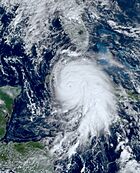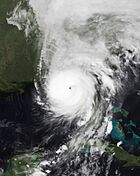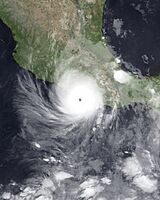Saffir–Simpson scale facts for kids
The Saffir–Simpson hurricane wind scale (often called SSHWS) is a way to measure how strong a hurricane is. It sorts hurricanes into five different groups, or categories, based on how fast their winds are blowing. This system helps people understand the possible damage a hurricane might cause when it hits land.
To be called a hurricane, a storm must have winds blowing at least 74 miles per hour (119 km/h). This is a Category 1 hurricane. The strongest storms are Category 5 hurricanes, with winds of 157 miles per hour (252 km/h) or more. The scale measures the highest wind speed averaged over one minute, 10 meters (about 33 feet) above the ground.
The Saffir–Simpson hurricane wind scale is mainly used for hurricanes in the Atlantic Ocean and the northern Pacific Ocean east of the International Date Line. Other parts of the world use different scales for similar storms, which they might call cyclones or typhoons. These other scales often measure winds over a longer time (like 3 or 10 minutes), which can make direct comparisons tricky.
Some people say the SSHWS doesn't include everything, like how much rain a storm brings or how high the storm surge (a big wall of ocean water) will be. However, others argue that the scale is meant to be simple and easy to understand, focusing just on wind speed. There have been ideas to add even higher categories, but these haven't been put into use yet.
Contents
History of the Hurricane Scale
The Saffir–Simpson scale was created in 1971 by two people: Herbert Saffir, a civil engineer, and Robert Simpson, who was the head of the U.S. National Hurricane Center (NHC) at the time. The public first learned about the scale in 1973.
Herbert Saffir first thought of the idea in 1969. He was working for the United Nations, studying how to build homes that could survive hurricanes. He realized there wasn't a simple way to describe how much damage a hurricane might cause. He looked at scales used for earthquakes, like the Richter scale, and came up with a simple 1-to-5 grading system. His original idea looked at wind gusts and how much damage they might cause to buildings.
| Grade | Wind Speed Range |
| Grade 1 | 120 - 140 km/h |
| Grade 2 | 151-180 km/h |
| Grade 3 | 181-210 km/h |
| Grade 4 | 211-240 km/h |
| Grade 5 | 241+ km/h |
Saffir shared his idea with the NHC. Robert Simpson then made some changes. He changed "grade" to "category" and made the wind speeds based on a 1-minute average. He also added information about storm surge height and air pressure, though these were later removed. The scale was first officially published in 1975.
In 2009, the NHC decided to remove the storm surge and air pressure information from the scale. This made it a "pure wind scale," which is why it's now called the Saffir–Simpson Hurricane Wind Scale (SSHWS). This change became official in 2010. They made this change because the storm surge and pressure information wasn't always accurate. For example, Hurricane Katrina (2005) and Hurricane Ike (2008) had stronger storm surges than expected for their wind category, while Hurricane Charley (2004) had a weaker one. Now, computer models are used to predict storm surge.
In 2012, the NHC slightly changed the wind speed range for Category 4 hurricanes. This was done to fix some rounding problems when converting wind speeds between knots, miles per hour, and kilometers per hour. This change didn't affect how past storms were classified.
Hurricane Categories
| Saffir–Simpson Hurricane Scale | ||||||
| TD | TS | C1 | C2 | C3 | C4 | C5 |
The Saffir–Simpson scale divides hurricanes into five categories based on their wind speed. In the Atlantic and Eastern/Central Pacific, hurricanes that are Category 3 or higher are called major hurricanes. The Joint Typhoon Warning Center calls typhoons with winds of 150 mph (240 km/h) or more (strong Category 4 and Category 5) super typhoons.
Most weather groups around the world measure sustained winds by averaging them over 10 minutes at a height of 33 feet (10 meters). However, the U.S. National Weather Service, Central Pacific Hurricane Center, and Joint Typhoon Warning Center use a 1-minute average at the same height, which is what the Saffir–Simpson scale uses.
Here are the five categories, from weakest to strongest:
Category 1 Hurricanes
| Category 1 | |
|---|---|
| Sustained winds | Most recent landfall |
| 33–42 m/s 64–82 kn 119–153 km/h 74–95 mph |
 Oscar in 2024 at landfall in Cuba Oscar in 2024 at landfall in Cuba |
Very dangerous winds will produce some damage
Category 1 storms can cause some damage, but usually not to strong, well-built buildings. They can knock over mobile homes that aren't tied down and break or uproot weak trees. Roof shingles might blow off. These storms often cause coastal flooding and damage to piers. Power outages are common and can last for several days. Even though they are the lowest category, Category 1 hurricanes can still be very dangerous.
Examples of Category 1 hurricanes at landfall: Isaac (2012), Nate (2017), Hanna (2020), and Oscar (2024).
Category 2 Hurricanes
| Category 2 | |
|---|---|
| Sustained winds | Most recent landfall |
| 43–49 m/s 83–95 kn 154–177 km/h 96–110 mph |
 Francine in 2024 at landfall near Morgan City, Louisiana |
Extremely dangerous winds will cause extensive damage
Category 2 storms often damage roofs, sometimes exposing the inside of the building. They can also damage poorly built doors and windows. Many trees are uprooted or broken. Mobile homes are usually damaged or destroyed, and many manufactured homes can suffer serious structural damage. Small boats in unprotected areas might break free. Power outages are widespread and can last for many days, and clean water might be lost.
Examples of Category 2 hurricanes at landfall: Juan (2003), Alex (2010), Sally (2020), and Francine (2024).
Category 3 Hurricanes
| Category 3 | |
|---|---|
| Sustained winds | Most recent landfall |
| 50–58 m/s 96–112 kn 178–208 km/h 111–129 mph |
 Rafael in 2024 just prior to its landfall in Cuba |
Devastating damage will occur
Category 3 storms and higher are called major hurricanes. These storms can cause structural damage to smaller homes and utility buildings. Buildings without strong foundations, like mobile homes, are usually destroyed. Roofs can be torn off.
Manufactured homes often get severe, unfixable damage. Flooding near the coast can destroy smaller buildings, and larger ones can be hit by floating debris. Many trees are uprooted or snapped, cutting off many areas. Inland areas can also flood. Power loss is likely to be almost complete and can last for weeks. Access to clean water will likely be lost or unsafe.
Examples of Category 3 hurricanes at landfall: Alicia (1983), Fran (1996), Jeanne (2004), Zeta (2020), and Rafael (2024).
Category 4 Hurricanes
| Category 4 | |
|---|---|
| Sustained winds | Most recent landfall |
| 58–70 m/s 113–136 kn 209–251 km/h 130–156 mph |
 Helene in 2024 just prior to its Florida Big Bend landfall |
Catastrophic damage will occur
Category 4 hurricanes cause even more widespread damage to walls and some complete structural failures in small homes. Gas station canopies and other large overhangs are often heavily damaged or completely destroyed. Mobile and manufactured homes are often flattened. Most trees, except the very strongest, are uprooted or snapped, leaving many areas isolated. These storms cause a lot of beach erosion. Land far inland can also be flooded. Total and long-lasting power and water losses are expected, possibly for many weeks.
Examples of Category 4 hurricanes at landfall: 1900 Galveston hurricane (1900), Donna (1960), Charley (2004), Harvey (2017), Ida (2021), and Helene (2024).
Category 5 Hurricanes
| Category 5 | |
|---|---|
| Sustained winds | Most recent landfall |
| ≥ 70 m/s ≥ 137 kn ≥ 252 km/h ≥ 157 mph |
 Otis in 2023 nearing its landfall in Acapulco, Mexico Otis in 2023 nearing its landfall in Acapulco, Mexico |
Catastrophic damage will occur
Category 5 is the highest category on the Saffir–Simpson scale. These storms cause complete roof failure on many homes and industrial buildings. Some small utility buildings might be blown over or away entirely. Many large roofs and walls, especially those without inside supports, can collapse. Wooden structures often suffer very heavy, unfixable damage, and mobile/manufactured homes are completely destroyed.
Only a few types of buildings can survive these storms without major damage, and only if they are located a few miles inland. These include buildings made of solid concrete or steel, multi-story concrete parking garages, and homes made of reinforced brick or concrete blocks with strong, sloped roofs and no overhangs. If a building doesn't meet most of these requirements, it could be completely destroyed.
Flooding from the storm causes major damage to the lower floors of all buildings near the coast. Many coastal structures can be completely flattened or washed away by the storm surge. Almost all trees are uprooted or snapped, and some might even lose their bark, cutting off most affected communities. Large-scale evacuations are often needed if a Category 5 hurricane threatens populated areas. Total and extremely long-lasting power and water losses are expected, possibly for several months.
Examples of Category 5 hurricanes at landfall: "Labor Day" (1935), Camille (1969), Andrew (1992), Irma (2017), Michael (2018), Dorian (2019), and Otis (2023).
See also
 In Spanish: Escala de huracanes de Saffir-Simpson para niños
In Spanish: Escala de huracanes de Saffir-Simpson para niños
- Beaufort scale – This scale connects wind speed to what you can see happening at sea and on land.
- Enhanced Fujita scale – This scale measures the strength of tornadoes based on damage and wind speeds.
- Hurricane engineering
- Outline of tropical cyclones

